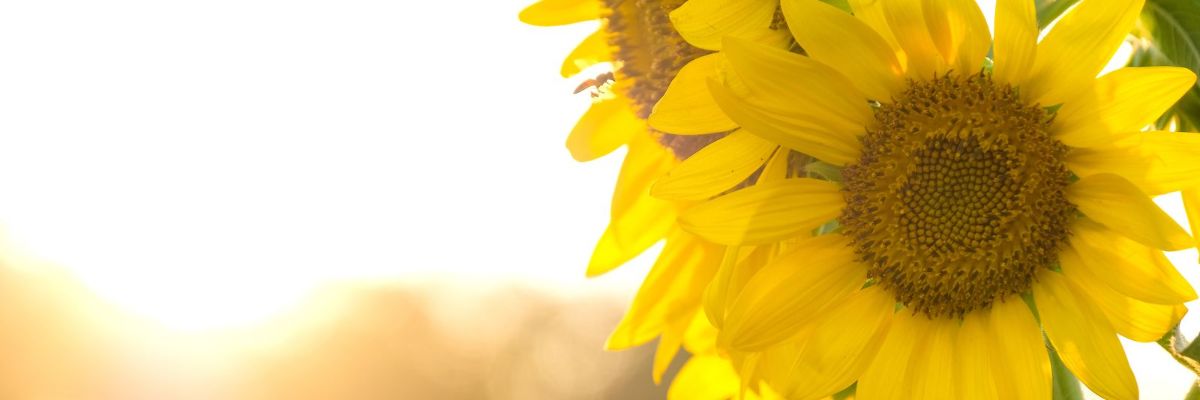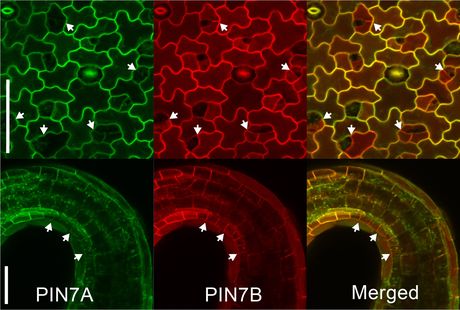
Auxin: the transport mechanism of a key plant hormone refined
24. 01. 2022
How do plants turn towards the light? Auxin tells them the way. Experts from the Czech Academy of Sciences (CAS) got a novel insight into the mechanism by which plants control the transport of this vital hormone. Two versions of the same protein that work against each other play the main role. Thus, they fine-tune the flow of auxin across the cells so that the plant grows and responds to stimuli correctly.
Auxin is conveyed between the cells by the transporter proteins located on the plasmatic membrane. However, several important details about the overall transporting mechanism are missing. Experts from the Institute of Experimental Botany of the CAS and CEITEC of Masaryk University have discovered that auxin flow is modulated by two proteins produced from a single gene. These proteins function against each other, yet in a highly cooperative manner.
“We have been puzzled over this for about two years when we thought each of them works separately. We observed that one protein does nothing on its own while the other performs too much. In the final, relatively desperate effort, we put them together, and it clicked,” explains Kamil Růžička from the Institute of Experimental Botany of the CAS.
One works, the other spoils
The essence of the discovery is the so-called alternative splicing in which two different proteins are synthesized according to the information written in one gene. Proteins called PIN carry out the auxin transport between cells in plants. The researchers focused on one of them, PIN7, and examined whether and how alternative splicing affects it.
“The PIN7 gene produces two different proteins. Simply told, while one protein is working too much, the other is hindering the work. Our research brought highly important results. Not only have we shown another evidence that alternative splicing influences auxin transport and plant development, but we have also uncovered an interesting mechanism by which the two proteins encoded by the PIN7 gene interact with each other and influence each other’s presence in specific spots on the cell membrane," says Kamil Růžička. Hence, the cooperation of the 'protein brothers' optimally tunes the auxin transport velocity for the plant to follow the light source properly.

Novel methods, novel views on auxin flow
Scientists have used several modern methods for experiments, from protein biochemistry to advanced microscopic techniques. "In many of the experiments, we needed to observe growth reactions in the seedlings of the experimental plant - arabidopsis. So, I constructed a computer system that automatically acquired pictures of the seedlings with cameras and used image analysis to help measure their growth," says Ivan Kashkan, a student of Kamil Růžička and the main author of the paper.
The research opens up a couple of possibilities for further research. For example, it revealed that auxin transporters associate together and demonstrated that they must be firmly attached to stable membrane structures (spots) to function properly. It is also tempting to speculate what processes can regulate the mutual levels of both proteins in the cell. From the practical point of view, new findings may perhaps bring new possibilities in breeding crops for better-utilizing sunlight.
The main contributors to the research were scientists from the Institute of Experimental Botany of the CAS and CEITEC. Other experts from Czech, Belgian and Finnish institutions were also part of the team. The paper was published in the distinguished scientific journal New Phytologist.
Text: Eliška Zvolánková, Division of External Relations, CAS Centre of Administration and Operations
Photos: Shutterstock; Ivan Kashkan, Institute of Experimental Botany of the CAS
Read also
- A trapped state: The pandemic impact on public attitudes, trust, and behavior
- Aerial archaeology: Tracing the footsteps of our ancestors from the sky
- Archaeologists uncover ancient finds along Prague Ring Road
- Our microbiome largely depends on what we eat, says microbiologist Michal Kraus
- The ABCs of writing: Why did its invention mark a turning point for humankind?
- We learn, remember, forget… What can memory actually do? And can we outsmart it?
- New Center for Electron Microscopy in Brno opens its doors to global science
- The hidden lives of waste: What can we learn from waste workers and pickers?
- A unique lab is hidden right beneath Prague’s Vítkov Hill
- Renewables are a strategic investment in European security, scientists say
The Czech Academy of Sciences (the CAS)
The mission of the CAS
The primary mission of the CAS is to conduct research in a broad spectrum of natural, technical and social sciences as well as humanities. This research aims to advance progress of scientific knowledge at the international level, considering, however, the specific needs of the Czech society and the national culture.
President of the CAS
Prof. Eva Zažímalová has started her second term of office in May 2021. She is a respected scientist, and a Professor of Plant Anatomy and Physiology.
She is also a part of GCSA of the EU.